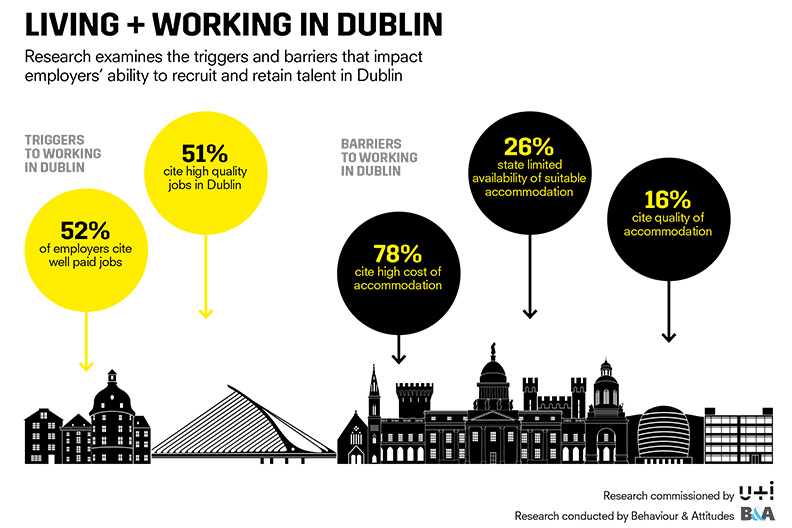Housing availability, recruitment and retention in Dublin
New research commissioned by specialist regeneration and property developer U+I shows that Dublin's housing crisis is seriously hampering business' efforts to recruit and retain talent in the city.
The 'Housing availability, recruitment and retention in Dublin' research, conducted by Behaviour & Attitudes, surveyed more than 100 senior hiring managers representing large national and international employers in Dublin. Despite a majority saying that well paid, high-quality jobs are the main attraction to working and living in Dublin, 78% of respondents said the high cost of accommodation is the single greatest obstacle in attracting talent to the city.
Three quarters of those surveyed also said that the limited availability of accommodation is hindering their efforts to recruit, as many young professionals and single middle-income earners are priced out of the Dublin market. This new research quantifies for the first time the challenges posed by the housing crisis to Dublin's position as an attractive location for international talent.
These findings are even more stark when considered alongside the research compiled by Amárach Research which found that the centre of Dublin is at risk of being 'hollowed out' accessible only to high earners at the expense of younger people, single person households and middle-income earners.
Following the publication of the research results, U+I chief executive Matthew Weiner said:
"We have seen much discussion in the media about the impact a shortage of the right kind of homes in the right locations is having on recruitment. This research provides hard evidence that this is a reality for employers. This is a real concern as attracting and retaining talent is the number one issue. Diversity, next generation talent and creativity are essential ingredients for a thriving modern city and the housing market needs to adapt and respond to ensure that Dublin maintains a competitive labour market and vibrant culture.
Matthew Weiner continued:
"The results of this research and other reports we have recently commissioned show, quite clearly, that consumer and lifestyle habits are changing. Young people in particular are living increasingly compact, experientially driven lives, looking to live and work in city centres. U+I has worked on a number of intelligently designed living solutions for housing and community focused mixed-use projects and its Compact Living model is one such example. These purpose-built, self-contained, rental-only homes have been designed to maximise available space and cater the needs of single person households.
Compact living is just one example of a broader suite of solutions, alongside thoughtful mixed-use regeneration, which we believe is required to tackle the housing supply challenges Dublin faces. Ideally, we would like to develop these types of innovative housing solutions on sites in association with public sector bodies, who have unused and underdeveloped land in Dublin City Centre. Such partnerships could release significant value for the public purse and provide housing options that are so urgently needed."
This article was originally published on 24th September 2018 by U+I.
--U and I
[edit] Related articles on Designing Buildings Wiki
Featured articles and news
RTPI leader to become new CIOB Chief Executive Officer
Dr Victoria Hills MRTPI, FICE to take over after Caroline Gumble’s departure.
Social and affordable housing, a long term plan for delivery
The “Delivering a Decade of Renewal for Social and Affordable Housing” strategy sets out future path.
A change to adoptive architecture
Effects of global weather warming on architectural detailing, material choice and human interaction.
The proposed publicly owned and backed subsidiary of Homes England, to facilitate new homes.
How big is the problem and what can we do to mitigate the effects?
Overheating guidance and tools for building designers
A number of cool guides to help with the heat.
The UK's Modern Industrial Strategy: A 10 year plan
Previous consultation criticism, current key elements and general support with some persisting reservations.
Building Safety Regulator reforms
New roles, new staff and a new fast track service pave the way for a single construction regulator.
Architectural Technologist CPDs and Communications
CIAT CPD… and how you can do it!
Cooling centres and cool spaces
Managing extreme heat in cities by directing the public to places for heat stress relief and water sources.
Winter gardens: A brief history and warm variations
Extending the season with glass in different forms and terms.
Restoring Great Yarmouth's Winter Gardens
Transforming one of the least sustainable constructions imaginable.
Construction Skills Mission Board launch sector drive
Newly formed government and industry collaboration set strategy for recruiting an additional 100,000 construction workers a year.
New Architects Code comes into effect in September 2025
ARB Architects Code of Conduct and Practice available with ongoing consultation regarding guidance.
Welsh Skills Body (Medr) launches ambitious plan
The new skills body brings together funding and regulation of tertiary education and research for the devolved nation.
Paul Gandy FCIOB announced as next CIOB President
Former Tilbury Douglas CEO takes helm.
UK Infrastructure: A 10 Year Strategy. In brief with reactions
With the National Infrastructure and Service Transformation Authority (NISTA).

























Comments
that is why i left Dublin